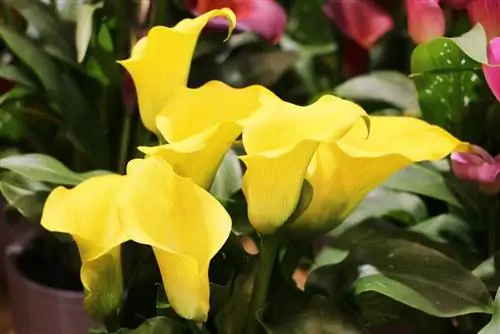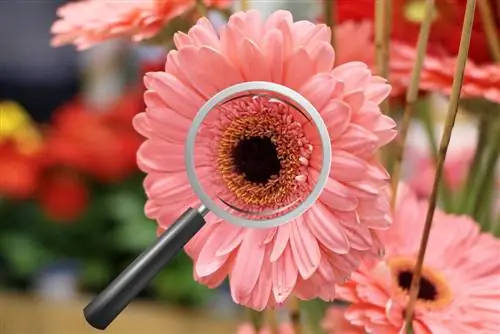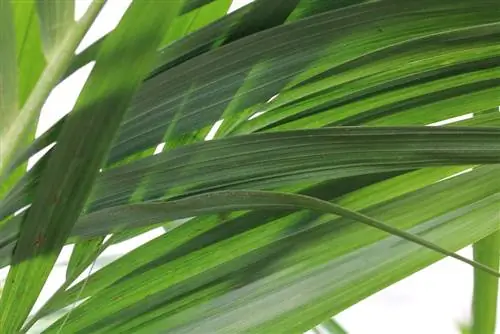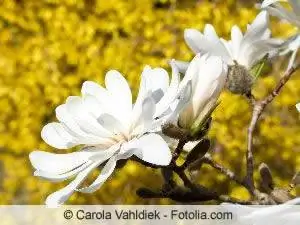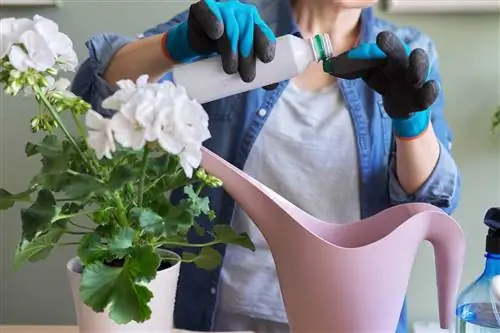- Author admin [email protected].
- Public 2023-12-17 03:39.
- Last modified 2025-01-24 12:45.
Houseplants are in pots and therefore need to be repotted every now and then. This not only serves to expand your space but also to refresh the earth. Potted plants in particular lose a lot of nutrients through weekly watering. However, especially when the plants have become very large, it can be difficult to repot the green plants, but with a little skill and the right instructions, which are described in detail below, any houseplant can be repotted quickly and easily.
Time
The first question that arises is when and why does the green plant need to be repotted; there are many reasons for this. If you notice that the roots are becoming too large, the plant is suffering from a lack of space in the pot or perhaps no longer grows at all, then it is time to repot. After three to four years at the latest, all plants should benefit from a new pot and fresh soil so that the used soil, which has usually completely lost its nutrients, can be disposed of. The best time to repot is usually spring, before new shoots sprout and new leaves form. The frequency of repotting is due to the following factors:
- Young plants must be given a new container every year
- they root even faster and grow larger so quickly
- Roots growing out of the drainage hole
- in some cases the pot breaks from the strong root system
- Older plants no longer form as many new roots
- They usually have enough space for longer
- Calcium deposits on earth
- Proportion of plant and container is no longer correct
- fresh soil is needed every three to four years
To see how far the rooting has progressed, the plant is briefly lifted out of its container with the entire root ball. This can prevent the pot from blowing up, which can happen quickly with bowed hemp or spider plants, for example. If the soil is not yet completely rooted, the plant can remain in the old container.
Tip:
If you deliberately want to keep the plant small, do not repot it in a larger container, even if the pot ball is already rooted. However, if you want more growth and freedom for the plant, you must now use a larger container.
Matching pot
If the plant needs more space, a larger container must be purchased. The new pot should be large enough so that the root ball that was removed from the old pot would have two to three centimeters more space all around in the new pot. But which material should ideally be chosen for a pot for houseplants:
- Clay pots are made of natural material
- the porous walls are permeable to air and water
- but this also means increased watering
- Waterlogging can largely be avoided here
- Stability is given, especially for large plants
- Plastic pots, on the other hand, are lighter
- they are easier to clean
- it doesn't need to be watered so often
- heavy, large plants can tip over more easily
Tip:
For plants with very long roots, a very high pot should be chosen, which not only looks beautiful but can also be very practical in such a case. Shallow-rooted plants, on the other hand, require rather low, wide pots.
Good potting soil
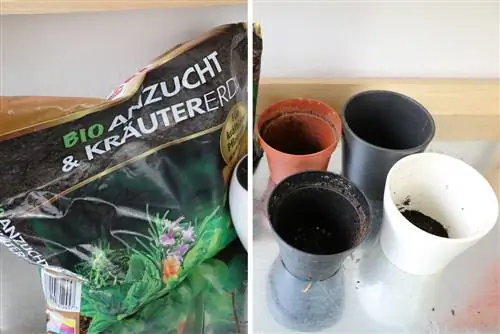
The next step is to choose the potting soil. This must provide high performance in the pot for the next few years. The water is stored and nutrients are released to the plants. In addition, the soil also has to buffer harmful substances and their effects, for example when watering with very calcareous water. Because houseplants only have a limited amount of space available in the pot, they have to use it as best as possible. The right potting soil can help with this. Therefore, the earth should be selected according to the following criteria:
- don't compromise on quality
- obtain high-quality potting soil
- unfortunately it's a little more expensive
- but it pays off over the period of use
- Cheap offers, on the other hand, tend to get moldy because they are not sterile
- are often contaminated, for example by fungus gnats
- The nutrient content is usually low in cheap soil
Tip:
If you want to do something good for nature, use peat-free or peat-rich potting soil. This serves to preserve the moors. The peat in these potting soil mixtures is usually replaced by wood or coconut fibers as well as compost and bark humus.
Special earth
However, not all houseplants tolerate the same soil composition. Therefore, some plants that grow on the windowsill require special soil. But this is also available in well-stocked garden shops, specifically tailored to the needs of these plants. There are special azalea, orchid and cactus soils that differ from normal potting soil because they have been mixed according to the special needs of these corresponding plant groups. But this special soil can also be chosen for other plants that have similar needs;
- The soil for orchids is more of a plant material
- here coarse components ensure good ventilation
- this is how charcoal or pieces of bark are mixed
- Water can also be drained away better this way
- Azalea soil has a particularly low pH value
- this is also compatible with other ericaceous plants
- Hydrangeas, camellias and rhododendrons are also well looked after with this
- Cactus soil, on the other hand, is very sandy
- so very water permeable
Tip:
Cactus soil is also particularly suitable for mixing with normal potting soil if even better water permeability is desired for one or another plant.
Repotting
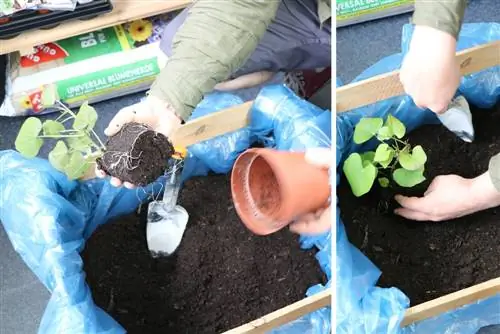
Once all the materials, such as pots and fresh soil, have been provided, then the actual repotting begins. A table to work on is helpful; for large potted plants you can also work on the floor. Ideally, a large sheet of plastic should be placed on the table and on the floor around the table, as there will always be a little soil spilling over it. Then work as follows:
- Carefully remove the plant from the old container
- remove old soil from the root ball as best as possible
- Also loosen the root ball slightly with your fingers
- create a drainage system in the new pot to prevent waterlogging
- to do this, spread pottery shards or gravel over the drain hole
- cover with plant fleece
- fill in a portion of fresh soil
- then insert the plant and fill in the remaining soil
- the roots must be completely covered
- Spread the soil well by shaking and water in
Of course, the same container can be used again if the plant doesn't need more space, but still needs fresh soil. Then, once the plant has been removed, the pot should be cleaned thoroughly before working with fresh soil again. To do this, the interior is well brushed under water with a brush so that the old soil is completely removed. Then continue as described above.
Tip:
Ideally, when repotting, you should always work with gardening gloves, or alternatively rubber gloves from the kitchen. This means your hands don't get dirty from the soil and not all plants should be touched with your bare hands, as parts or sap of them could be poisonous and can cause skin irritation.
Special cases
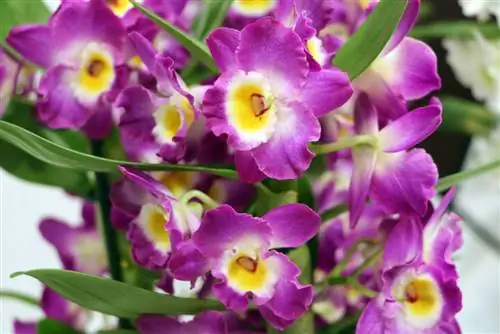
When repotting houseplants, as with everything, there are special cases that must be taken into account. For example, cyclamen or camellias, which have their main flowering period in late winter, must not be repotted in spring; for these plants, the ideal repotting time is the time after flowering has ended, which may well not be until early summer. Orchids or palm trees, on the other hand, are very sensitive to the roots. Therefore, it should only be repotted in an extreme emergency.
Repotting in hydroponics
Houseplants are often grown using so-called hydroponics, which is a very easy-care culture system. Therefore, plant lovers in particular who do not want to put in a lot of care and who are perhaps often away from home have their green treasures in hydroponics. The containers are only filled with water to a certain level every two to three weeks; long-term fertilizer is also sufficient. However, these plants can also outgrow their container, but only in such a case do they have to be repotted. In such a case, the expanded clay does not necessarily have to be replaced, but it can happen that white limescale deposits can form here, like on old soil. Then new clay should be used. When repotting houseplants in hydroponics, proceed as follows:
- If the roots completely fill the pot, it needs to be repotted
- even if the water drainage slots are already growing over with roots
- Removing expanded clay
- move into larger, new pot insert
- fill in some moist expanded clay here in advance
- Put the expanded clay in a water bath in advance
- Place the plant and fill with more expanded clay
- fill with water
- give long-term fertilizer at the same time
Rejuvenate by division
Some houseplants can also be rejuvenated by dividing them in the root medium two to three times. This has the nice side effect that additional plants can be cultivated. This rejuvenation makes the most sense directly when repotting, as the houseplants are removed from the old pot. The division then proceeds as follows:
- use a sharp knife
- cut the roots into three or four parts
- some plants can also be divided by hand
- simply break the roots apart in the middle
- plant all new plants received in prepared pots
- water sparingly at the beginning
- wait until the plants are rooted
Rejuvenation helps the plants grow stronger again. The houseplants that can be divided include, among others, all ferns, arrowroot, indoor bamboo, cyper grass, coral moss, bobhead, ornamental asparagus and indoor oats.
Conclusion
Every plant, especially houseplants that are usually grown in pots, need a rejuvenation treatment from time to time. Not only should they be repotted every three to four years to create more space, fresh soil is also helpful for continued he althy growth. With a little skill, anyone can repot their houseplants quickly and easily. If all the necessary resources are provided, such as a new pot, new soil and a large plastic bag for the table and floor, it is quick and easy. Since falling earth is always to be expected, it is best to carry out the work in a room that can be cleaned quickly later. If you have a balcony or terrace available, you can move the work here.

